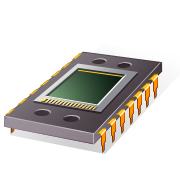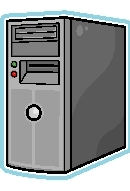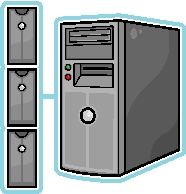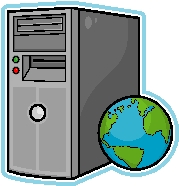-1- The Seismographic sensor.
The seismographic sensor consists of
a geophone and an AD converter (analog
to digital converter.
The geophone continuously generates
analog data by picking up vibrations
from the surface it is mounted on. The
vibrations are transformed into an
analog electric signal.
The analog signal then is digitized
by the sensor's A/D converter.
-2- The A/D converter.
The analog signal generated by the
geophone needs to be converted
to a stream of digital data so it can
used and processed by a computer.
This is done by using a so called
Analog to Digital (A/D) converter.
This converter digitizes the signal
to a BCD (Binary Coded Decimal)
value and buffers the digitized data.
The binary data can now be accessed
and read from the sensor with a computer.
-3- The Data Logger.
The data logger is a computer that is
connected to a sensor and logs the data.
The seismograph's data logger also controls
the sensor and sends commands to the A/D
converter to continuously check and validate
the data that was digitized.
The logger timestamps the raw data and
stores it locally.
The last 2 minutes of data are formatted
and via a wireless connection stored in a
MySQL database server for easier access.
The logger continously retrieves data
from the sensor and adds some extra
information that shows the sensor status
at the moment the data was retrieved.
-4- The Wifi Link.
The data logger and sensor are somewhat
remotely located, and are connected to the
LAN via a dedicated wireless link.
-5- The Local Network.
All computers that are used for
retrieving, processing and displaying
the seismic data from the sensor are
connected to a local network.
The computers involved are:
- a data logger.
- a database server.
- a web server.
- a display or kiosk.
- a PC, laptop or other device.
The data logger and the sensor can be
located anywhere on the Internet
separately from the DB server and
from kiosk and other clients
-6- The Database.
The last 2 minutes of data retrieved by the
data logger are stored in a simple via the
web accessible database.
Not all data is permanently stored in this
database since a lot of data is so called
back ground noise. All the raw data is stored
in a different location in a more efficient
and more compact data format.
The data stored on this database server is
used by web based applications that
display it in a browser window.
-7- The Web Server.
The seismic data is displayed with web based
applications on the World Wide Web.
Special applications are developed to display
the continuous stream of data in a browser window.
The webpages of this seismograph can be accessed
by anyone from anywhere on the internet.
-8- The Kiosk or Dedicated work station
Data can be displayed on/in a kiosk, a large TV, or
just a work station or other device.
-9- The Internet.
The local network is connected to
the Internet and the online seismograph
is accessible via the World Wide Web.








